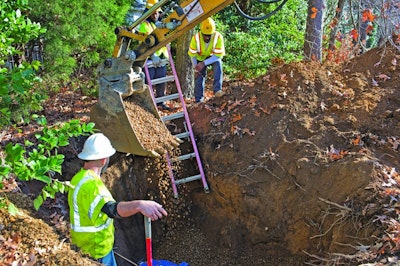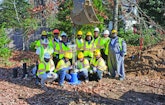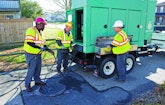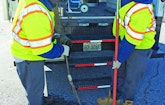
Interested in Trucks?
Get Trucks articles, news and videos right in your inbox! Sign up now.
Trucks + Get AlertsTwelve years ago the City of Virginia Beach got a wake-up call.
Its name was Hurricane Isabel.
The 2003 storm was the worst in recent memory and led to severe power outages, according to Tom Leahy, Virginia Beach director of public utilities.
The power loss didn’t just turn out the lights and shut off refrigerators. It severely hampered the city’s sanitary sewer system.
With more than 10 percent of the city’s sanitary sewer collections system consisting of force mains, Virginia Beach relies on an extensive collection of pumping stations to move its sewer flows. When Isabel hit, only 15 of the 390 sewer pumping stations had built-in generators. The utilities department realized “that we were going to have to spend a lot more money adding generators to these sewer pump stations.”
The experience helped Virginia Beach turn around its sewer system operations and maintenance practices — moving from a reactive approach to a proactive one.
The aftermath of the hurricane wasn’t the only reason for the change in direction. And Leahy emphasizes it’s still a work in progress.
“Our goal is a sustainable operation in which we’re able to keep up with the aging of the system,” Leahy says. “We’re not quite there yet.”
SSOs and blockages
For several decades, Virginia Beach grew rapidly — first with the merger of Princess Anne County and the Town of Virginia Beach, and then as the local population soared. As the city grew, so did its sanitary sewer system — mostly through new development, but also with the extension of public sanitary sewer systems into neighborhoods that had lacked the service and by acquiring old, failing private systems within the city’s boundaries.
Then the growth tapered off and the population leveled off. The city is currently home to about 440,000 people. By the turn of the millennium, says Leahy, “We came to realize that a lot of the infrastructure built by developers and deeded over to the city was now getting old — it was wearing out.”
A major symptom of problems was an increasing number of sewer system blockages and sanitary sewer overflows. “Our blockages and SSOs were increasing every single year,” Leahy says. “My predecessor, Clarence Warnstaff, consulted with Jim Sarver, manager of the operations division, and they initiated a cleaning program.”
Meanwhile, the federal EPA proposed Capacity, Management, Operation and Maintenance (CMOM) standards in 2001. Although the federal government never formally implemented those standards, Virginia Beach officials thought they made a lot of sense, Leahy says. “We started working toward implementing the spirit of those.”
Then came the hurricane. Immediately after Isabel, 90 percent of the sewer pumping stations had no power. Five days after the storm, more than 30 percent of the 390 stations were still without power.
“For 30 years before that, the longest power outages the city had suffered [during a hurricane] was for a day or two,” says Leahy. “It was nothing like we had ever dealt with before.”
Pump up the volume
The system consists of 1,500 miles of gravity sanitary sewer mains and 180 miles of sewer force mains.
Virginia Beach has added 18 pump stations since Isabel, bringing the utility’s total to 408. But with an average age of 30 years across the system, many of its stations are more than 40 years old, dating back to the 1960s and ’70s, the city’s big growth period.
Each station is a fairly complex electrical and mechanical facility, and they all require regular maintenance.
After cleaning up from Isabel, the sewer utility began stocking up on generators, both permanently installed and portable units, says Daniel Lane, utility mechanic supervisor in the city’s Sanitary Sewer Pumping Station Bureau.
The utility also undertook a project to upgrade the pump stations — part of a larger series of capital projects that began seven years ago. As stations are replaced or rebuilt, dry well stations are being converted to submersible stations, which cost less, Leahy explains.
“We’ve put a lot of resources into our sewer pumping stations — rebuilding and rehabbing them, cleaning them on a regular basis,” Lane says.
Scheduled maintenance
The capital budget increase was part of a broader program begun in 2007. That year the Hampton Roads Sanitary District, which treats the region’s sanitary sewage, signed a consent order with the EPA. The 14 communities sending flows to the district, including Virginia Beach, signed as well, agreeing to increase capital investment and improve maintenance.
Virginia Beach, assisted by a consultant and guided by the CMOM standards, implemented a systematic approach to inspection and maintenance, explains Daren Williams, public utilities operations and maintenance engineer.
Adding up all the assets in the system — valves, air vents, pumps and so on — the utility established how often and over what period of time it would operate each asset. “For valves, we assumed that we would operate all valves within a year,” Williams says. “For manual air vents, we decided to operate all vents within the system in five years.”
Working from those numbers, the utility then calculated monthly and annual goals to keep it on track with exercising every asset within the time allotted.
Utility employees reviewed the history of sewer pipe structural defects, such as bellies and insufficient grades, that would lead to blockages. They viewed CCTV videos to further analyze the causes of SSOs. Their findings helped establish a cleaning cycle, which then set the pace for monthly cleaning goals for gravity sewer mains in the Virginia Beach Hot Spot cleaning program.
“After a few years of operating and maintaining the system with preventive maintenance goals, we realized that we responded to fewer emergencies,” says Williams. Other aspects of the system were added to the program, such as cleaning vacuum collection tanks at least twice a year in parts of the community with heavy tourist traffic.
Force mains 4 inches or less in diameter that send flows to gravity sewer manholes are flushed every three months — once a quarter — as part of a bypass pumping program implemented to reduce emergency repairs. Previously, he explains, pumps frequently had to be repaired or replaced in lift stations with small force mains, or the mains had to be cut open and cleaned due to clogging.
Similar goals were set for other aspects of maintenance, such as replacing backup batteries at sewer pump stations every five years. The goal for cleaning gravity mains is 65,000 to 75,000 feet per month.
The goals were fed into the utility’s computer maintenance management system, which generates monthly work orders that are distributed to superintendents. As work orders are completed, superintendents review them to help keep the system accountable, Williams says. In its annual report, the utility logs the number of lateral repairs, main repairs and pump station repairs for the year; all that data is reported annually to the Virginia Department of Environmental Quality.
Inspection, cleaning, repair and replacement
But probably the biggest single change was in how the city deployed manpower.
“We used to have 10 repair crews,” says Elijah Smith, assistant superintendent for the wastewater collections bureau. “What we decided to do was focus more on finding and fixing [problems].”
Virginia Beach reorganized the crews into maintenance crews. Each crew of two people is assigned to a Vacall sewer-cleaning truck. The city has five trucks as well as three dedicated video-inspection trucks.
Now as inspections uncover bottlenecks in the lines, crews will clean them out immediately if they can without much trouble. “We don’t wait until we have major problems,” Smith says.
The utility’s annual cleaning goal calls for covering about 1 million feet per year, about 10 percent of the system. “It’s had a tremendous reduction in our SSOs and in our stoppages,” Leahy says.
Attention to cause
The reorganization has enabled crews to take a closer look at causes of particular problems.
“It used to be if someone responded to a blockage and cleared the lateral and there was grease there, it was just reported as a grease blockage,” Leahy says. And if the real cause was some other defect, it might go undetected, requiring a return trip when the problem recurred.
The practice now is to televise the problem line as the first step so crews can be sure of what the real source of the blockage or other problem is. “Now the philosophy is to get in there, fix it and never have to come back to this address again,” Leahy says.
At the same time, every call becomes an opportunity to look for more problems. “Every time we have a blockage or SSO, we go out and TV the line upstream and downstream of the area,” Leahy says. Any defects encountered are slated for repair or replacement as soon as possible — even if they weren’t responsible for the problem that led to the call in the first place.
Virginia Beach has also stepped up enforcement of existing regulations requiring food service establishments to pretreat their wastewater, instituting a program of inspections to confirm they are following the rules and are properly maintaining their grease traps. From less than 5 percent compliance when the program started, “now we’re in the 60 to 79 percent range,” Leahy says. “We’ve gone from almost no compliance to two-thirds compliance.”
Dramatic results
Between the capital investment, the find-and-fix policy, the grease-reduction program, root control and regularly scheduled cleaning, “it’s had a phenomenal improvement on both our overflows and our sewer blockages,” Leahy says. It’s hard to say which gets the most credit, he adds. “They’re all contributing at the same time.”
“Find and fix” is more expensive in the short term, he observes, but it also helps prevent bigger problems. “I can’t argue with the results. Our SSOs have really plummeted.”
SSOs were once in the neighborhood of 200 a year. “These days we are always under 20,” Leahy says. And in 2013, the number was a mere dozen. “We’ve dropped down to less than one SSO per 100 miles of line.”










